Free Online Productivity Tools
i2Speak
i2Symbol
i2OCR
iTex2Img
iWeb2Print
iWeb2Shot
i2Type
iPdf2Split
iPdf2Merge
i2Bopomofo
i2Arabic
i2Style
i2Image
i2PDF
iLatex2Rtf
Sci2ools
DGO
2011
2011
Social media use by government: from the routine to the critical
Social media (i.e., Twitter, Facebook, Flickr, YouTube) and other services with user-generated content have made a staggering amount of information (and misinformation) available. Government officials seek to leverage these resources to improve services and communication with citizens. Yet, the sheer volume of social data streams generates substantial noise that must be filtered. Nonetheless, potential exists to identify issues in real time, such that emergency management can monitor and respond to issues concerning public safety. By detecting meaningful patterns and trends in the stream of messages and information flow, events can be identified as spikes in activity, while meaning can be deciphered through changes in content. This paper presents findings from a pilot study we conducted between June and December 2010 with government officials in Arlington, Virginia (and the greater National Capitol Region around Washington, DC) with a view to understanding the use of social media by g...
| Added | 18 Dec 2011 |
| Updated | 18 Dec 2011 |
| Type | Journal |
| Year | 2011 |
| Where | DGO |
| Authors | Andrea L. Kavanaugh, Edward A. Fox, Steven D. Sheetz, Seungwon Yang, Lin Tzy Li, Travis Whalen, Donald Shoemaker, Paul Natsev, Lexing Xie |
Comments (0)

